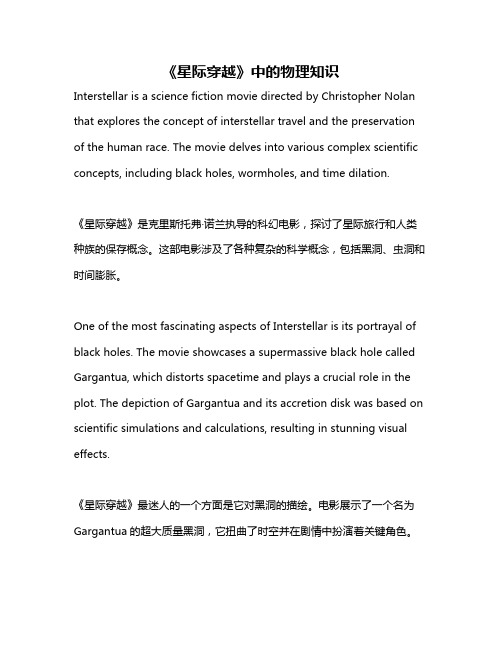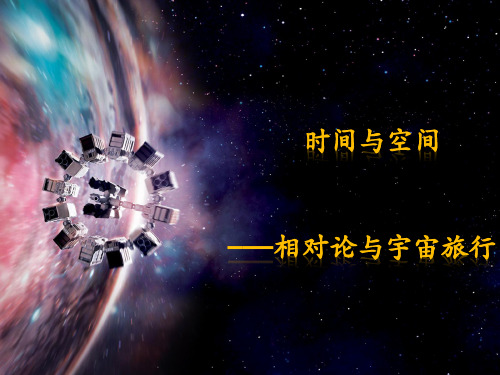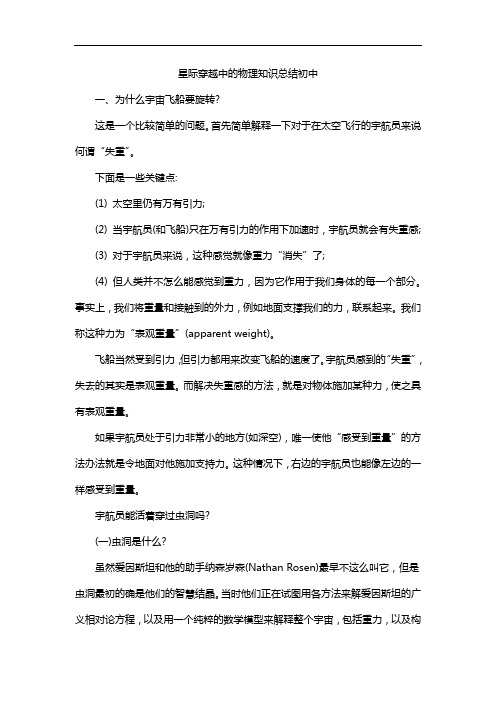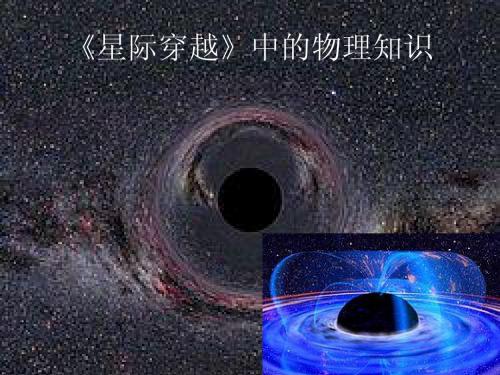星际穿越所涉及的物理知识
星际穿越牛顿第三定律

星际穿越牛顿第三定律
“星际穿越”是一部讲述人类为了生存而进行太空探索的电影,而其中的牛顿第三定律是非常重要的物理原理之一。
牛顿第三定律在这部电影中的应用也非常明显。
牛顿第三定律,也称作牛顿作用力定律,指出了两个物体间相互作用的力是同等大小但方向相反的。
在“星际穿越”中,宇航员们在太空站和船舱之间进行转移时,需要依靠牛顿第三定律的原理。
当宇航员推动他们穿着的“推进器”时,推动力会产生反作用力,将他们本身的体重向后推。
这个反作用力提供了足够的向后推力,使宇航员能够在真空环境下穿越太空并到达目标。
在电影的最后,当宇航员们在黑洞里进行救援行动时,牛顿第三定律的应用也非常重要,因为黑洞产生的引力会对宇航员产生巨大的吸引作用力。
牛顿第三定律告诉我们,宇航员可以通过施加相反的反向推力,尽可能地抵消黑洞的吸引力,以此保持自己的活动和生存。
总之,牛顿第三定律是一个基本的物理原理,对于人们在太空中进行探索和生存至关重要。
在“星际穿越”中,我们可以看到它的应用,也更加深入地了解到这个定律的重要性。
用科学电影学习物理知识

用科学电影学习物理知识科学电影作为一种娱乐形式,不仅可以带给观众精彩的视觉效果和情节,还可以通过科学的角度来呈现物理知识。
观看科学电影不仅可以让我们放松心情,还可以在娱乐中学习到一些有趣的物理知识。
本文将介绍几部科学电影,探讨其中蕴含的物理知识。
一、《星际穿越》《星际穿越》是一部由克里斯托弗·诺兰执导的科幻电影。
该电影讲述了人类为了寻找新的生存环境而进行太空旅行的故事。
影片通过黑洞、时空裂缝等物理概念,揭示了时空旅行和引力场的奥秘。
1. 时空裂缝在电影中,时空裂缝是人类进行太空旅行的关键。
时空裂缝是一种理论上存在的时空弯曲现象,能够连接不同的时空点,实现超光速航行。
通过这一概念,观众可以初步了解时空的曲折性和扭曲性,从而对爱因斯坦的广义相对论有一定了解。
2. 黑洞电影中的主要情节之一是探索黑洞。
黑洞是一种极其巨大且密度特别大的天体,其引力非常强大,甚至连光都无法逃逸。
在电影中,通过探索黑洞,人类找到了一个新的宜居星球。
观众通过对黑洞的描述和展示,能够初步了解黑洞的形成和特性。
二、《银翼杀手2049》《银翼杀手2049》是一部科幻电影,它是经典电影《银翼杀手》的续集。
电影中呈现了未来世界中的科技发展和人类与机器人之间的矛盾与交融。
在电影中,通过对电子技术和人工智能的探索,我们可以学习到一些物理知识。
1. 量子计算在电影中,人工智能格罗夫是通过量子计算来实现自我思考和感知的。
这使观众了解到了量子计算的概念。
量子计算是一种基于量子力学原理的计算方式,它具有更高的计算速度和更强的计算能力,能够解决传统计算机无法解决的问题。
2. 虚拟现实电影中虚拟现实技术的出现让人类能够进入一个虚拟的世界,并与其中的人工智能进行互动。
这种技术给观众展示了可能的未来科技发展方向。
观众可以通过这一情节了解到虚拟现实技术的基本原理和应用。
三、《浴血战士》《浴血战士》是一部科幻动作片,该电影让观众在惊险刺激的故事中感受到了物理学的魅力。
《星际穿越》中的物理知识

《星际穿越》中的物理知识Interstellar is a science fiction movie directed by Christopher Nolan that explores the concept of interstellar travel and the preservation of the human race. The movie delves into various complex scientific concepts, including black holes, wormholes, and time dilation.《星际穿越》是克里斯托弗·诺兰执导的科幻电影,探讨了星际旅行和人类种族的保存概念。
这部电影涉及了各种复杂的科学概念,包括黑洞、虫洞和时间膨胀。
One of the most fascinating aspects of Interstellar is its portrayal of black holes. The movie showcases a supermassive black hole called Gargantua, which distorts spacetime and plays a crucial role in the plot. The depiction of Gargantua and its accretion disk was based on scientific simulations and calculations, resulting in stunning visual effects.《星际穿越》最迷人的一个方面是它对黑洞的描绘。
电影展示了一个名为Gargantua的超大质量黑洞,它扭曲了时空并在剧情中扮演着关键角色。
对Gargantua及其吸积盘的描绘是基于科学模拟和计算的,导致令人惊叹的视觉效果。
星际穿越讲物理

———相对论与宇宙旅行
时空的认知过程
亚里士多德————绝对空间与时间 伽利略,牛顿————时间是绝对的,空间
是相对的
爱因斯坦————时间与空间都是相对的
相对论的意义
狭义
广义水塔时钟Βιβλιοθήκη GPS定位开启星际之旅
如果星际旅行接近黑洞,会如何? 黑洞:黑洞是空间中有着强大引力的超高
密度的天体。接近黑洞会导致时间变慢。
《星际穿越》(INTERSTELLAR)
四维空间
光锥与时空
电影中呈现的五维空间
第五维指的是能量无界限,是由无数个第
四维时间组成的平面。想象一下,就像你 面前有一堵墙由无数的竖线组成,每一条 竖线 就是一条第四维时间线,透过每一 条时间线都能看到在这个时间点三维空间 里发生的事情。这画面就好像上帝在看每 一个人类的生活一样,很神奇,在“第五 维度” 的世界里没有时间或是空间的界限。
不要温和地走进那个良夜。白昼将尽,暮 年仍应燃烧咆哮。怒斥吧,怒斥光的消逝。
影视中的初中物理知识

影视中的初中物理知识一、万有引力定律《星际穿越》是一部以太空探险为题材的科幻电影,其中展现了宇宙中的万有引力。
根据万有引力定律,物体之间的引力与它们的质量和距离有关。
在电影中,主人公们穿越黑洞,探索其他星系,正是通过理解和应用万有引力定律,才能成功地进行星际旅行。
二、速度和加速度在《速度与激情》系列电影中,主角们驾驶着各种超级跑车进行惊险的飙车,这涉及到速度和加速度的物理概念。
速度是物体在单位时间内所经过的路程,而加速度是速度随时间变化的快慢。
电影中的高速追逐和曲线漂移都是通过掌握加速度的原理来展现的。
三、光的折射和反射在电影《千与千寻》中,千寻进入了一个神奇的世界,其中光的折射和反射成为了重要的情节。
折射是光线从一种介质进入另一种介质时改变传播方向的现象,而反射是光线遇到光滑表面时发生的反弹现象。
电影中的神奇场景和迷人的光影效果正是通过运用了光的折射和反射原理而实现的。
四、简单机械原理在《海底总动员》系列电影中,小丑鱼多莉经历了一系列冒险和探险,展示了简单机械的原理。
比如,杠杆原理被应用在多莉和鱼友们合力推起船帆的场景中,这是因为杠杆可以通过减小力的作用面积来增加力的作用效果。
电影中还有滑轮和斜面等简单机械的运用,通过这些场景,观众可以更直观地了解简单机械原理。
五、能量转化和守恒定律在电影《变形金刚》系列中,变形金刚们可以将自己的能量转化为各种形式,并运用于战斗中。
这涉及到能量转化和守恒定律的物理原理。
能量转化是指能量从一种形式转变为另一种形式的过程,而能量守恒定律则表明能量在转化过程中总量保持不变。
通过变形金刚们的能量转化和战斗,观众可以更加直观地感受到能量转化和守恒的重要性。
通过以上几个例子,我们可以看到初中物理知识在影视作品中的应用。
影视作品通过生动的场景和故事情节,将抽象的物理概念变得具体而有趣,帮助观众更好地理解和记忆这些知识。
因此,我们在学习物理知识时,也可以借鉴影视作品的方法,通过实际场景和实例来加深对物理知识的理解。
星际穿越影评:科普影片中涉及到的六个烧脑物理学“常识”

星际穿越影评:科普影片中涉及到的六个烧脑物理学“常识”诺兰的烧脑电影《星际穿越》正在热播中,网上各种精彩影评接踵而来,学霸们人人神勇,个个争先,你让俺们这些学渣情何以堪!难道不是物理学霸就看不懂《星际争霸》?小编整理了片中涉及到的六个物理学烧脑“常识”,帮助大家理解。
一、黑洞基帕·索恩在「黑洞与时间弯曲」这本著作的开篇讲了一个一支太空探险队在太空中探索黑洞的经历,故事挺无趣的,基本上就是形象地说了现代科学家对黑洞的研究成果:1什么是黑洞黑洞是空间中有着强大引力的超高密度的天体,假如太阳质量不变,大小却变成乒乓球那样,这就是太阳坍缩成了黑洞。
黑洞的特点就是有进无出,即:①任何东西都可以掉进黑洞,黑洞外围有一层“事件视界”,任何东西只要过了这个“视界”,都要掉进黑洞。
②任何东西都不可能从黑洞里逃出来,包括光。
另外,因为没有光从黑洞逃出,故无法直接观测黑洞,但是从物体被黑洞吸入之前放出的紫外线、X射线等边缘信息可以获取黑洞的存在。
2黑洞潮汐力一只很大的飞船飞向一个天体,飞船头部距离天体比较近,受到的引力比较大,而尾部距离天体比较远,受到的引力比较小,头部和尾部的引力大小的差距,就会在飞船中间产生撕扯的拉力,这个拉力就是潮汐力。
如果天体是黑洞,质量非常大,飞船距离黑洞距离越小时,造成的引力差就会越大,这就是黑洞潮汐力。
这个力甚至可以把飞船撕成碎片。
飞船里的宇航员也同样会受到潮汐力的作用,对于一般我们接触的物体,即使我们到达它的表面所产生的潮汐力也没有多大,但是,如果是黑洞这种超大质量超大密度的天体,则有可能产生很大的潮汐力将物体撕碎。
二、虫洞下面就说说「黑洞与时间弯曲」的第十四章虫洞和时间机器这一章的内容:首先,基帕·索恩说了一件他的趣事:1985年,基帕·索恩接到多年老朋友卡尔·萨根的求助。
卡尔写了一本科幻小说,希望把小说里的科学理论写的准确一点,想让基帕·索恩指点一下。
星际穿越运用到的物理知识

星际穿越运用到的物理知识主要包括:
1. 虫洞:虫洞是连接两个遥远时空的多维空间隧道。
在
电影中,虫洞的概念是基于广义相对论和量子力学理论的假设。
它连接了两个星系之间的时空,通过这个通道,人类可
以迅速穿越宇宙。
2. 黑洞:在电影中,黑洞的概念是基于广义相对论的理论。
黑洞是一种由爱因斯坦-罗森桥连接的两个时空的区域,
其中一个区域是一个具有强引力场的星体。
当物质被吸入黑
洞时,它以辐射的形式发射出来,形成所谓的“霍金辐射”。
3. 引力弹弓效应:引力弹弓效应是利用行星的重力场来
给太空探测船加速,将它甩向下一个目标,也就是把行星当
作引力助推器。
在电影中,人类利用引力弹弓效应穿越星际
空间。
4. 钟慢效应:钟慢效应是相对论中的一个概念,指的是
在运动中时间会变慢。
在电影中,这个概念被用来解释为什
么地球上的时间流逝得比在宇宙中快。
5. 巨浪现象:在电影中,巨浪现象是由于米勒星球上的
黑洞作为引力源形成的一种现象。
巨浪是由黑洞的强大引力
产生的,它具有巨大的能量和破坏力。
这些物理知识的运用,为电影构建了一个科学、合理的宇
宙探索和时间旅行的故事背景。
看电影谈物理《星际穿越》1

科幻电影是好莱坞类型电影里的一个分支。 包含了各种各样的科学奇想,有依附于现有已知 科学定理的,也有关于未来图景的超前假想。 下面,以科幻电影《星际穿越》为例,其中有一 些影视作品所钟情的物理元素,从中探寻科幻电影 和物理学之间的联系。星际穿越] 发射升空.mp4
时空Байду номын сангаас越
米勒星球的巨浪
米勒星球上的时间膨胀
逃离黑洞
库伯为什么没被撕碎
五维空间盒子
狭义相对论:
随着速度的增加,
物体质量——增加
空间——尺缩效应 时间——钟慢效应
钟慢效应(时间膨胀)
Tship
v Tearth (1 2 ) c 2
2
虫洞
又称爱因斯坦-罗森桥,是宇 宙中可能存在的连接两个不同时空
的狭窄隧道。
星际穿越的虫洞“they”
黑洞
某些大质量恒星会终结为一 个黑洞——时空中的某些区域发 生极度的扭曲以至于连光都无法 逸出
星际穿越中的物理知识总结初中

星际穿越中的物理知识总结初中一、为什么宇宙飞船要旋转?这是一个比较简单的问题。
首先简单解释一下对于在太空飞行的宇航员来说何谓“失重”。
下面是一些关键点:(1) 太空里仍有万有引力;(2) 当宇航员(和飞船)只在万有引力的作用下加速时,宇航员就会有失重感;(3) 对于宇航员来说,这种感觉就像重力“消失”了;(4) 但人类并不怎么能感觉到重力,因为它作用于我们身体的每一个部分。
事实上,我们将重量和接触到的外力,例如地面支撑我们的力,联系起来。
我们称这种力为“表观重量”(apparent weight)。
飞船当然受到引力,但引力都用来改变飞船的速度了。
宇航员感到的“失重”,失去的其实是表观重量。
而解决失重感的方法,就是对物体施加某种力,使之具有表观重量。
如果宇航员处于引力非常小的地方(如深空),唯一使他“感受到重量”的方法办法就是令地面对他施加支持力。
这种情况下,右边的宇航员也能像左边的一样感受到重量。
宇航员能活着穿过虫洞吗?(一)虫洞是什么?虽然爱因斯坦和他的助手纳森岁森(Nathan Rosen)最早不这么叫它,但是虫洞最初的确是他们的智慧结晶。
当时他们正在试图用各方法来解爱因斯坦的广义相对论方程,以及用一个纯粹的数学模型来解释整个宇宙,包括重力,以及构成物质的各种粒子。
其中包括的一种方法是将空间描述成两个几何面,其间由“桥”连接,而在我们的感知中,这些桥就是粒子。
1916年,另外--位物理学家路德维希弗拉姆(LudwigFlamm),同样是在解爱因斯坦的方程的时候,独立发现了这些“桥”。
不幸的是,这个“万有理论”并不成功,因为这些“桥”的表现并不像是真正的粒子。
但是爱因斯坦和罗森在1935年发表的论文使得“穿越时空结构的隧道”这个概念得以流行,其它物理学家不得不认真地考虑这些隧道带来的影响。
20世纪60年代,普林斯顿大学的物理学家约翰惠勒(John Wheeler)在研究“爱因斯坦罗森桥”的数学模型时,创造了“虫洞”这一术语。
星际穿越10个物理知识

星际穿越10个物理知识《星际穿越》在全球热映,这部以太空穿梭和时空旅行为题材的科幻片被奉为“烧脑神作”,想要看懂这部影片,没点基础知识可不行哦,快来学习一下下面的知识吧。
1、黑洞真是洞?《星际穿越》主要讲述了一对探险家利用他们针对虫洞的新发现,超越人类对于太空旅行的极限,从而开始在广袤的宇宙进行星际航行的故事、除看过《星际穿越》也有不少人以为黑洞真的是洞!事实上,黑洞并不是洞,它不是空的,恰恰相反,黑洞是宇宙空间内存在的一种超高密度天体,由于类似热力学上它是完全不反射光线的黑体,故名为黑洞。
黑洞的质量极其巨大,而体积却十分微小,它产生的引力场极为强劲,以至于任何物质和辐射在进入到黑洞的一个事件视界(临界点)内,便再无力逃脱,甚至目前已知的传播速度最快的光(电磁波)也逃逸不出。
理论上讲,黑洞本是一颗恒星,然而它最终没有熄灭或爆炸,而是像做塌了的蛋奶酥一样,坍塌成一个小小的、不可逃逸的奇点。
2、什么是虫洞?这一名词诞生于上世纪50年代,是对“爱因斯坦-罗森桥”的一种通俗称呼,它指的是物理学中假想的一种天体,能从更高的维度连接两个遥远的空间点,因此可以使人类突破光速的临界,进行超远距离的宇宙航行,片中一名科学家用纸笔对此作了一番形象的演示。
从上世纪80年代开始,归功于美国加州理工学院物理学家基普·索恩的理论,虫洞被广泛用于幻想作品中的星际旅行,而索恩也正是《星际穿越》的科学顾问。
影片中的虫洞以球形示人,正展示了这一超空间结构的独特性质:来自更高维度的物体在三维空间的投射。
3、翘曲飞行?通过在高纬度折叠空间而航行的方式,被称为翘曲飞行,尽管在影片中并没有出现这一名词,但在原理上一脉相承。
在动辄光年量级的宇宙中,使用翘曲飞行,既不破坏因果律,又实现了超光速。
在科技更发达的《星际迷航》等电影中,人类已经可以用飞船自带的引擎进行翘曲飞行,而《星际穿越》中,宇航员不得不借助更高级生命为他们“量身定做”的虫洞来达到这一目的。
星际穿越

维度(dimension )
• 0维是一点,没有长度。1维是线,只有长度。2维是一个 平面,是由长度和宽度(或曲线)形成面积。3维是2维加上 高度形成“体积面”。虽然在一般人中习惯了整数维,但 在分形中维度不一定是整数,而可能会是一个非整的有理 数或者无理数。 • 我们周围的空间有3个维(上下,前后,左右)。我们可 以往上下、东南西北移动,其他方向的移动只需用3个三 维空间轴来表示。向下移就等于负方向地向上移,向西北 移就只是向西和向北移的混合。 在物理学上时间是第四维,与三个空间维不同的是,它只 有一个,且只能往一方向前进。 • 我们所居于的时空有四个维(3个空间轴和1个时间轴), 根据爱因斯坦的概念称为四维时空,我们的宇宙是由时间 和空间构成,而这条时间轴是一条虚数值的轴。 有些理论预言我们所居于的宇宙实际上有更多的维度
虫洞(Wormhole)
• 又称爱因斯坦-罗森桥,是宇宙中可能存在的连接两个不同时空的狭 窄隧道。虫洞是1916年奥地利物理学家路德维希·弗莱姆首次提出的 概念,1930年由爱因斯坦及纳森·罗森在研究引力场方程时假设的, 认为透过虫洞可以做瞬时的空间转移或者做时间旅行。 • 由阿尔伯特·爱因斯坦提出该理论。简单地说,“虫洞”就是连接宇 宙遥远区域间的时空细管。暗物质维持着虫洞出口的敞开。虫洞可以 把平行宇宙和婴儿宇宙连接起来,并提供时间旅行的可能性。[1] 虫 洞也可能是连接黑洞和白洞的时空隧道,所以也叫"灰道"。 • 理论上,虫洞是连结白洞和黑洞的多维空间隧道,就像是大海里面的 漩涡,是无处不在但转瞬即逝的。这些时空漩涡是由星体旋转和引力 作用共同造成的。就像漩涡能够让局部水面跟水底离得更近一样,能 够让两个相对距离很远的局部空间瞬间离得很近。不过有人假想一种 奇异物质可以使虫洞保持张开也有人假设如果存在一种叫做幻影物质 (Phantom matter)的奇异物质的话,因为其同时具有正能量和负质 量,因此能创造排斥效应以防止虫洞关闭。 虫洞(Wormhole),或 译作蛀孔或蠹孔,又称爱因斯坦-罗森桥,是宇宙中可能存在的连接 两个不同时空的狭窄隧道。迄今为止,科学家们还没有观察到虫洞存 在的证据。为了与其他种类的虫洞进行区分,一般通俗所称“虫洞” 应被称为“时空虫洞”。[2]
星际穿越物理知识解析

星际穿越物理知识解析星际穿越,哎哟,这可是个话题!一说到这部电影,脑海里就浮现出那飞速穿梭在宇宙中的飞船,令人热血沸腾的场景,还有那些复杂的物理知识。
让我们来聊聊,这些看似高大上的物理知识其实是多么有趣,哈哈!重力这个东西,真的是个大明星,尤其是在这部电影里。
想象一下,重力像个调皮的孩子,时不时给你个“惊喜”,让你在不同的星球上感受到时间的流逝可不一样。
在黑洞附近,时间简直像是打了鸡血,过得飞快,唉,真是让人心情复杂,难以把握。
再说说那艘飞船,名字就叫“逆风”,多有诗意啊,哈哈!在太空中,它可不只是个漂浮的铁块,而是运用了很多我们平常听不懂的物理原理。
比如,光速这个玩意儿,谁都知道光速飞快,可在飞船上,想要达到那样的速度,得想尽办法,真是脑筋急转弯。
黑洞、虫洞、超光速,听着就像科幻小说里的情节。
可事实是,这些概念可不是空穴来风。
科学家们可都是在拼命研究,想要揭开宇宙的秘密,简直是从黑暗中摸索出光明。
谈到黑洞,简直就是宇宙里的“无底洞”。
在电影中,黑洞被描绘得神秘又恐怖,像是一个吞噬一切的怪物,让人不由得想起那些关于宇宙的无数问题。
你看啊,黑洞周围的时空弯曲得厉害,仿佛一张无形的网,把一切都牢牢束缚住。
我们这些普通人,可能连飞向太空的勇气都没有,想象一下掉进黑洞,那可是个什么样的场景!听说掉进去的人,最后只剩下了无尽的孤独,心情可想而知。
然后就是虫洞,这东西简直是通往另一世界的“快捷通道”。
想象一下,你在地球上,突然就能瞬间到达另一个星系,这得多酷啊!电影里的角色们就是这么干的,真让人羡慕。
不过,别太激动,现实中虫洞还只是个理论,科学家们都在拼命研究,但要实现这个目标,恐怕得等好久好久。
说不定那时候,科技发展得飞起,咱们都能轻松出游宇宙,嘿嘿!还有时间膨胀,这可是一件相当神奇的事!你在太空飞得飞快,回到地球发现,朋友们都老了,而你却还是那个年轻的小伙子,真是让人哭笑不得。
想象一下,时间像是个调皮的孩子,时而快,时而慢,让你根本抓不住。
物理题,星际飞船阻力

物理题,星际飞船阻力
星际飞船是现代科技发展的产物,承载着人类探索宇宙的梦想。
在星际航行过程中,阻力是一个不可忽视的问题。
本文将探讨星际飞船阻力产生的原因、影响以及降低阻力的方法,旨在为未来星际航行提供一些有益的参考。
一、星际飞船概述
星际飞船是一种具有高度先进技术的太空探测器,其任务是穿越宇宙空间,探索其他星球及行星。
星际飞船在航行过程中,需要克服多种外部因素,其中之一就是阻力。
阻力是指物体在运动过程中,由于与周围介质相互作用而产生的阻碍运动的力。
在星际航行中,阻力会严重影响飞船的航行速度、燃料消耗以及航行效率。
二、阻力产生的原因及影响
1.气体阻力:星际飞船在穿越宇宙空间时,会与周围的气体发生相互作用。
这种相互作用会产生阻力,降低飞船的航行速度。
2.颗粒阻力:在宇宙空间中,存在大量的尘埃和颗粒。
飞船在航行过程中,会与这些颗粒发生碰撞,产生颗粒阻力。
3.电磁阻力:星际飞船在航行过程中,会产生磁场、电场等电磁现象。
这些电磁现象与周围环境相互作用,产生电磁阻力。
4.引力阻力:星际飞船在航行过程中,可能会受到其他天体的引力影响,产生引力阻力。
阻力的存在对星际飞船的航行性能产生了显著影响。
首先,阻力会导致飞船的速度降低,增加燃料消耗。
其次,阻力会使飞船的航行轨迹发生变化,影
响探测任务的准确性。
最后,阻力还可能对飞船的机体造成损伤,缩短飞船的使用寿命。
星际旅行的物理学与工程学问题

星际旅行的物理学与工程学问题随着科技的不断发展,星际旅行已经成为了人们梦想的一部分。
然而,要实现星际旅行不仅需要突破物理学上的各种限制,还需要解决许多工程学上的难题。
本文将会深入探讨星际旅行的物理学与工程学问题,带领读者了解星际旅行的可能性以及所需面临的挑战。
一、能源问题驱动星际飞船所需的能源是一个巨大的问题。
必须寻找一种能源,能够为飞船提供持续并且高强度的驱动能力。
目前,使用最为广泛的是核能源,但这种能源也存在着安全性和环保问题。
因此,科学家们正在探索新型的能源技术,如反物质、氢弹等。
二、速度问题若要实现星际旅行,必须克服当前光速所带来的限制。
现代物理学认为,光速是一个不可逾越的界限,任何物体都无法达到或超过光速。
因此,我们需要寻找一种更快的速度。
许多科学家提出了一些新的理论,如弯曲时空、超光速以及获得星际旅行所需的相对论驱动。
三、空间探测问题在进行星际旅行前,我们需要对目标行星进行详细的勘测和研究。
但是,由于行星之间的距离太过遥远,以目前的技术无法进行准确的空间探测。
要解决这个问题,我们需要开发出更强大的探测仪器和技术,以及更高性能的能源。
四、隔离问题星际旅行中最严重的问题之一是隔离问题。
在太空环境中,人类将会遭受到各种形式的辐射和宇宙尘埃。
如何保护飞船的乘员免受这些危害,则成为了一个重要问题。
从飞船的设计、材料、人员的选择和培训等各个方面,需要对隔离问题进行全面考虑。
五、环境控制问题在长时间的星际旅行中,飞船内的环境将对乘员的生命和健康产生重要的影响。
飞船必须具备完备的环境控制系统,以维持良好的空气质量、水质量和温度条件等。
在这个过程中,需要考虑到尽可能减少浪费、并确保能源使用的效率。
六、自给自足问题在星际旅行中,要实现自给自足的生存,需要对诸如植物养殖、水源制备、食品营养以及废物管理等各种问题进行全面的研究。
科学家们需要开发出能够在太空中生长和产生食物的引擎,以及对船员精神和身体健康进行维护的系统。
星际探索中的物理学问题

星际探索中的物理学问题星际探索是人类一直以来追求的目标之一,但是在实现星际探索的过程中,我们需要面对很多难题,其中物理学问题是最重要的一部分。
本文将介绍在星际探索中可能遇到的几个物理学问题,以及可能的解决办法。
一、时间和空间星际探索的一个主要难题是时间和空间。
人类现在只能使用光速以内的速度进行移动,也就是说,即使是最近的恒星系统也需要数十年的时间才能到达。
在光速到达的地方,需要解决的问题是时间。
根据狭义相对论,时间是相对的,而人类时间尺度与宇宙时间尺度是不同的。
在星际旅行中,相对论效应会导致时间延缓或加速,这意味着在一段旅行期间,人类和地球之间的时间会有巨大的差异,这给我们的交流和协调带来了巨大的挑战。
其次是空间问题。
即使研究出一种能够到达恒星的高速飞船,也会面临着尺寸和质量的巨大限制。
通过新的推进系统,获得巨大的速度需要占用巨大的空间,而高速度下的撞击力也需要特殊的材料才能承受。
二、宇宙辐射在太空中,宇宙辐射是一个极大的威胁。
宇宙中存在着各种辐射,包括宇宙射线(包括高能质子),伽马射线,X射线等等。
这些辐射对人体和电子设备都是有害的。
目前人类对于宇宙辐射的了解还十分有限,因此在进行星际探索时,需要特殊的设备和保护来保护探索者。
此外,对于电子设备的保护也是一个巨大的挑战,因为宇宙辐射可以导致电子设备失效。
三、引力和运动在太空中,不能采用地球上常用的引力方法来控制运动。
在微弱的引力作用下,船只的运动十分复杂,因此必须采取不同的方法来协调和控制运动。
另一个问题是船只的速度,因为星际航程需要极高的速度,因此需要新的制动方法。
四、行星降落如果想要进行星际探索,就必须考虑如何降落在其他星球上面。
在进入行星轨道后,必须通过新的降落方法来控制船只。
在大气层中的降落需要一种新的技术,因为在太空中没有空气阻力。
总结在星际探索中,物理学问题是最重要的一个问题。
要实现星际探索,我们必须面对和解决以上提到的几个物理学问题。
星际宇宙的物理性质与探测技术

星际宇宙的物理性质与探测技术星际宇宙是人类探索的一个无限广阔的领域,涉及到许多复杂的物理性质和探测技术。
在人类的探索中,科学家们不断地寻找新的方法和技术,以便更好地研究和理解星际宇宙的奥秘。
一、物理性质1. 重力场重力场是星际宇宙中最显眼的物理性质之一。
在太阳系中,所有的行星和卫星都受到太阳的重力影响。
在星际宇宙中,大规模的重力场影响着星系和星系之间的运动,这会对星系的形状和行为产生影响。
2. 磁场除了重力场外,磁场也是星际宇宙中重要的物理性质之一。
星际磁场是由行星和恒星产生的电流和电磁辐射所组成。
磁场可以影响宇宙尘埃的移动,也可以通过加速带电粒子间接影响恒星的活动。
3. 辐射场辐射场是指星际宇宙中的电子、质子和光子等粒子的排布和相互作用。
它们在宇宙空间中运动并相互作用,这可以导致辐射事件。
强辐射场可以对太阳系中的电磁场和行星磁场产生影响。
二、探测技术1. 望远镜望远镜是星际宇宙探测的主要工具之一。
望远镜可以使用不同的光学技术,以可见光、红外线和X射线等形式,观察天体的形态和行为。
近年来,望远镜也可以通过望远镜网络联网,以提高观测精度和覆盖范围。
2. 无人探测器无人探测器也是星际宇宙探测的重要工具之一。
无人探测器可以通过精确的导航系统和先进的传感器,调查星际宇宙中的特定区域。
其优势在于可以远离地球的干扰,快速获得大量数据。
3. 空间探测器空间探测器是星际宇宙探测的另一种形式。
空间探测器可以进入地球轨道或进入外太空,通过载荷、成像、通信等手段,获得星际宇宙的多种信息。
通过数据分析与地面密切合作和协调,取得了许多重要的发现。
结语星际宇宙在人类的探索中显得越来越重要。
在实现人类对宇宙深入认识的过程中,科学家们必须在复杂的物理性质和高度复杂的仪器技术之间找到平衡点。
通过不断的探索和发现,将有助于我们令我们更加深入了解与星际宇宙相关的知识。
【精析】看《星际穿越》必懂的18个天文物理及理论问题

【精析】看《星际穿越》必懂的18个天文物理及理论问题猜目前还有不少人还没看过《星际穿越》这部电影吧?有木有?有木有?有的话推荐看一下文于2014年的“博科园”的混编文…首发于百度平台今在这里精编一下给大家梳理呈现《星际穿越》同时做为目前有史以来最科学的科幻电影~当然也是很强的烧脑大片…下面将较详细的为大家分析一下整部电影所涉及的天文物理及理论问题的烧脑问题、当时有人说《星际穿越》是学霸看的电影,也有人说是理科生看的电影…看完本帖你不论不是学霸还是理科生都能看懂此片!粗略简科普~欢迎做详细解释说明或指误~详细知识内容请参考各:文献资料或论文等看懂《星际穿越》你可能需要懂或知道:相对论、量子力学、黑洞,虫洞理论等物理知识…《星际穿越》将宇宙学研究与电影结合的如此完美…堪称目前最科学的科幻电影《星际穿越》长达169分钟,诺兰式强大的“烧脑”叙事情节不在话下,最让网友挠头的是各种天文、物理概念,“该片的高冷气质皆因随处可见的‘弯曲时间’、‘宇宙黑洞’、‘引力使光扭曲’等等……让本片接近科教片的行列”…赞不赞?18个问题目录分别是:(问题当然不止于18看个人怎么分了)TOP.1:黑洞真是洞?TOP.2:什么是虫洞?【No.1】TOP.3:什么是虫洞?【No.2】TOP.4:五维空间TOP.5:奇点TOP.6:时间膨胀TOP.7:与女主人公名字相同的定律:墨菲定律TOP.8:我们熟识的“相对论”TOP.9:引力弹弓TOP.10:如果真有高维空间,为什么我看不到?TOP.11:什么是穿越?TOP.12:虫洞真实存在吗?TOP.13:为什么Cooper乘坐的飞船要不停的旋转?TOP.14:Cooper航行的目的地是哪?离地球有多远?TOP.15:为什么Miller行星上面会有巨浪TOP.16:为什么Cooper从Miller行星返回后已经过去二十多年并且Romily已经老了?TOP.17:真实的虫洞和黑洞看起来是什么样子的?TOP.18:Murph的鬼魂是怎么回事?为什么Cooper在虫洞中可以观察到所有的历史事件?Cooper和Murph是怎样实现通讯的?注:排序不分排名或先后只在方便阅读TOP.1:黑洞真是洞?《星际穿越》主要讲述了一对探险家利用他们针对虫洞的新发现,超越人类对于太空旅行的极限,从而开始在广袤的宇宙进行星际航行的故事、除看过《星际穿越》也有不少人以为黑洞真的是洞!事实上,黑洞并不是洞,它不是空的,恰恰相反,黑洞是宇宙空间内存在的一种超高密度天体,由于类似热力学上它是完全不反射光线的黑体,故名为黑洞。
星际穿越物理知识点归纳

星际穿越物理知识点归纳
《星际穿越物理知识点归纳》
嘿,小伙伴们!你们有没有想过,当我们仰望星空,那些遥远的星球和神秘的宇宙背后,藏着多少超级有趣的物理知识呀?今天就让我这个小小探索家来给大家讲讲星际穿越里的那些神奇物理知识吧!
先来说说时间膨胀。
这可太神奇啦!就好像我们在地球上过了一天,而在宇宙中高速飞行的宇航员却可能只过了几个小时。
这难道不像我们在学校上课,觉得时间过得超级慢,可一玩起来,时间就像飞一样快吗?
还有黑洞,那可是个超级大的“怪物”!它的引力强得吓人,能把一切都吸进去,连光都跑不出来。
这就好比一个超级大的“贪吃鬼”,永远吃不饱,啥都要吞进肚子里。
再讲讲引力弹弓效应。
想象一下,一艘宇宙飞船就像一个小球,在行星的引力场中被“弹来弹去”,从而获得更快的速度。
这不就像我们在操场上玩弹弓,把小石子弹得老远一样吗?
还有那个相对论,可复杂啦!不过简单来说,就是当物体运动速度越快,时间就过得越慢,长度也会变短。
这难道不奇怪吗?难道我们跑得越快,就会变得越瘦越年轻?
在星际穿越中,还有好多好多这样神奇的物理知识呢!比如说虫洞,那是连接两个遥远时空的隧道,就像我们在城市里走地下通道,一下子就能从一个地方到另一个地方,省了好多路。
小伙伴们,你们说宇宙是不是超级神奇?这些物理知识是不是让我们对宇宙充满了好奇?难道我们不应该努力去探索更多关于宇宙的奥秘吗?
我觉得呀,宇宙就像一个巨大的宝藏,等待着我们去发现。
而这些物理知识就是打开宝藏的钥匙。
我们一定要好好学习,说不定未来的某一天,我们也能亲自去探索那神秘的星际之旅呢!。
物理题,星际飞船阻力

物理题,星际飞船阻力
(最新版)
目录
1.星际飞船的阻力问题
2.物理学中的阻力概念
3.星际飞船如何克服阻力
4.阻力对星际飞船的影响
正文
在星际探险和太空旅行中,星际飞船需要克服许多困难和挑战,其中之一就是阻力问题。
对于星际飞船而言,阻力是一种需要克服的物理障碍,它会影响飞船的速度和燃料消耗,甚至可能对飞船造成损坏。
因此,深入了解物理学中的阻力概念,以及星际飞船如何克服阻力,对我们了解太空旅行和星际探险具有重要意义。
首先,让我们来了解一下物理学中的阻力概念。
阻力是物体在运动时所受到的一种与运动方向相反的力,它会降低物体的速度,增加物体的能量消耗。
在星际飞船的情况下,阻力主要来自于太空中的气体和尘埃,以及飞船本身与太空中的物质摩擦所产生的热量。
那么,星际飞船如何克服阻力呢?一种方法是通过改进飞船的设计,使其具有更好的空气动力学特性,降低阻力。
另一种方法是通过使用先进的推进技术,如离子发动机和电磁驱动器,这些技术可以大大减少飞船的阻力,提高其速度和效率。
最后,让我们看一下阻力对星际飞船的影响。
阻力会增加飞船的能量消耗,导致燃料的浪费,可能影响飞船的航程和飞行时间。
此外,阻力还可能对飞船造成物理损伤,如磨损和过热,这可能会影响飞船的寿命和性能。
总的来说,星际飞船的阻力问题是一个复杂而又重要的问题。
- 1、下载文档前请自行甄别文档内容的完整性,平台不提供额外的编辑、内容补充、找答案等附加服务。
- 2、"仅部分预览"的文档,不可在线预览部分如存在完整性等问题,可反馈申请退款(可完整预览的文档不适用该条件!)。
- 3、如文档侵犯您的权益,请联系客服反馈,我们会尽快为您处理(人工客服工作时间:9:00-18:30)。
星际穿越所涉及的物理知识
Interstellar travel, the idea of travelling between stars or planets outside our solar system, involves a deep understanding of various physical principles. From the challenges of achieving near-light speeds to the effects of time dilation and gravity, the physics of interstellar travel is complex and fascinating.
星际旅行是指在太阳系之外的星球或行星之间进行旅行的想法,它涉及对各种物理原理的深入理解。
从实现接近光速的挑战到时间膨胀和引力的影响,星际旅行的物理学是复杂而迷人的。
One of the key principles of interstellar travel is the concept of relativity, as described by Albert Einstein in his famous theory. According to the theory of relativity, as an object moves closer to the speed of light, time slows down for that object relative to a stationary observer. This time dilation effect means that time passes slower for a fast-moving spaceship than for those on Earth, leading to the famous "twin paradox" where one twin ages more slowly than the other.
星际旅行的一个关键原则是相对论的概念,正如阿尔伯特·爱因斯坦在他著
名的理论中所描述的那样。
根据相对论的理论,当一个物体接近光速时,相对于静止观察者而言,该物体的时间会减慢。
这种时间膨胀效应意味着对于快速移动的飞船,时间流逝得比地球上的人慢,导致了着名的“孪生子悖论”,其中一个孪生子比另一个慢老。
Another key consideration in interstellar travel is the immense distances involved. Even our closest stellar neighbor, Proxima Centauri, is over 4 light-years away from Earth. Travelling at close to the speed of light, it would still take over 4 years to reach Proxima Centauri, highlighting the vastness of interstellar space and the challenges of reaching other star systems.
星际旅行中的另一个关键考虑因素是所涉及的巨大距离。
即使是我们最近的恒星邻居—半人马座比邻星,距离地球超过4光年。
以接近光速的速度行进,仍需要超过4年的时间才能到达半人马座比邻星,凸显了星际空间的广阔性和到达其他恒星系的挑战。
The challenges of interstellar travel also extend to the energy requirements of such a journey. In order to accelerate a spacecraft to near-light speeds, enormous amounts of energy would be needed,
far beyond our current capabilities. Concepts such as antimatter propulsion or solar sails have been proposed as potential solutions, but they remain theoretical and face significant engineering challenges.
星际旅行的挑战也延伸到了这样一次旅行所需的能量。
为了加速一艘飞船至接近光速的速度,需要大量的能量,远远超过我们当前的能力。
已经提出了反物质推进或太阳帆等概念作为潜在的解决方案,但它们仍然是理论性的,并面临着重大的工程挑战。
The effects of gravity also play a significant role in interstellar travel. As a spaceship accelerates close to the speed of light, it experiences increased gravitational forces that can affect both the crew and the spaceship itself. Managing these gravitational effects is crucial for ensuring the safety and stability of long-duration interstellar missions.
引力效应也在星际旅行中扮演着重要的角色。
随着飞船加速接近光速,它经历了增加的重力作用,这可能会影响到机组人员和飞船本身。
管理这些引力效应对于确保长时间星际任务的安全性和稳定性至关重要。
In conclusion, the physics of interstellar travel presents a myriad of challenges and opportunities for exploration. From the principles of relativity and time dilation to the vast distances and energy requirements, interstellar travel requires a deep understanding of physics and innovative solutions to overcome the obstacles. While the dream of reaching the stars may seem distant, the exploration of interstellar travel pushes the boundaries of human knowledge and technology, inspiring us to reach for the stars and beyond.
综上所述,星际旅行的物理学提出了众多挑战和探索的机会。
从相对论和时间膨胀的原则到广阔的距离和能量需求,星际旅行需要对物理学的深入理解和创新解决方案以克服障碍。
虽然到达星辰的梦想可能看起来遥不可及,但对星际旅行的探索推动了人类知识和技术的边界,激励我们不断追求星星及更远的目标。
